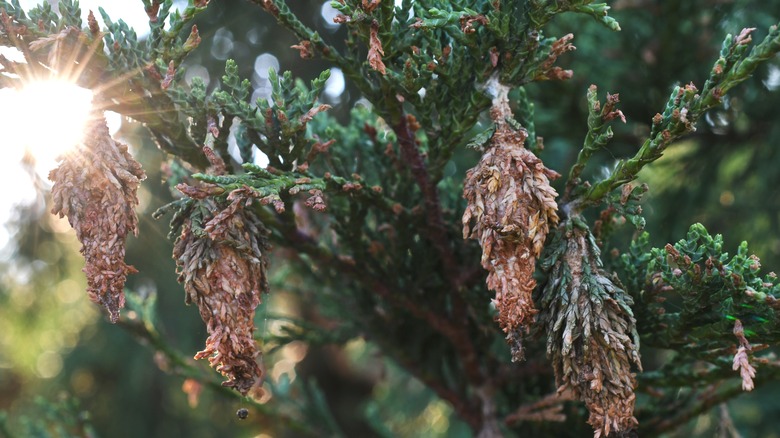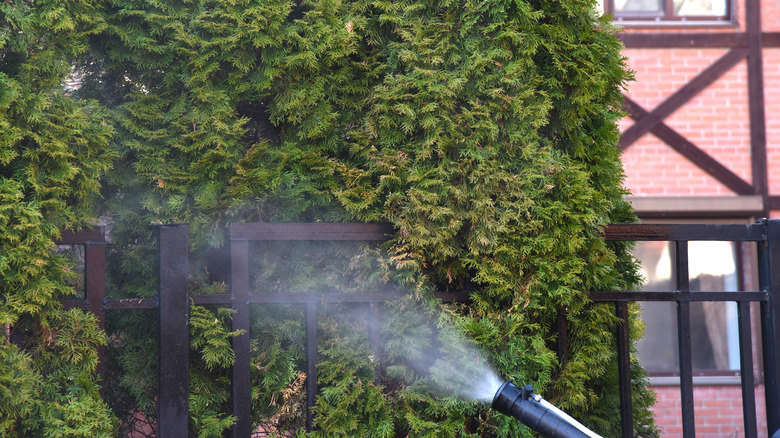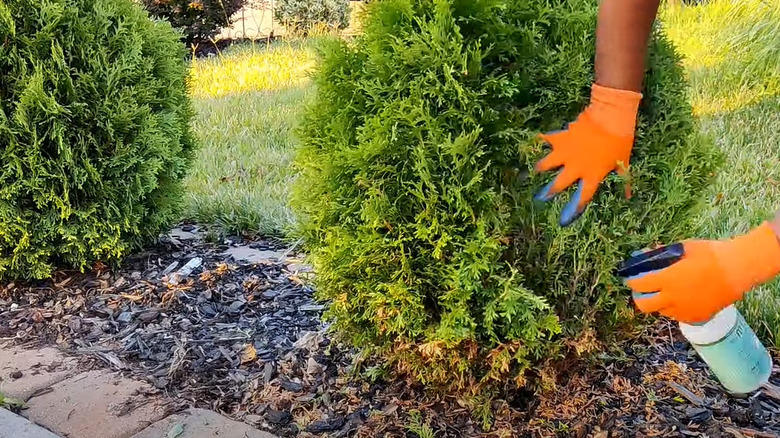Help Keep Bagworms Off Your Trees With One All-Natural Ingredient
We may receive a commission on purchases made from links.
To the untrained eye, it's easy to overlook the discrete and subtle peskiness that is the bagworm. These insects can silently turn your once-lush trees, especially conifers, into a devastated battlefield. Encased in their self-spun silken retreats, these resilient leaf-munching nuisances dangle from tree branches like ill-boding ornaments. The earliest sign of bagworms on trees is when evergreen needles assume an unnatural brown color, with severe infestation causing the untimely and tragic demise of whole trees. Detecting their presence early on can be the key to the survival of your lofty green companions. Your first instinct might be to reach for synthetic pesticides, but why introduce harsh elements into your serene space when Mother Nature offers an all-natural solution for getting rid of bagworms? Enter neem oil.
Neem oil, powered by its Azadirachtin component, operates in such an underhandedly sophisticated manner that these tiny tree terrorists simply don't stand a chance. Applying this oily agent enshrouds the larvae of bagworms, obstructing the breathing pores they rely on. Essentially, it suffocates these pesky tree munchers while also making them unable to feed. It also subtly meddles with the bagworm larvaes' hormonal balance, halting them from progressing to the next stage of their lifecycle. This all-natural savior assures a bagworm-free sanctuary that's unscathed by synthetic chemicals. However, this ingredient is harmful when breathed in and can irritate the skin and eyes. Because of this, wear gloves, a mask, and goggles when handling.
How to apply neem oil for bagworm treatment on your trees
Let your eco-conscious defense draw upon the potency of 100% pure concentrated neem oil (for instance, a 16-ounce bottle of Best Naturals 100% Pure Neem Oil is available for just $10 on Amazon). However, transforming this potent extract into a formidable shield over your foliage demands dilution — a blend of 2 tablespoons of neem oil per 1 gallon of water in a bucket is ideal. Also add a few drops of liquid soap to the mix — it serves as an emulsifier, a crucial element for binding oil and water molecules together.
When using neem oil in your garden, arming yourself with the appropriate spraying equipment is critical. A spray bottle won't do this mission justice if you're targeting giant trees. Instead, opt for something with a bit more force and coverage. A garden sprayer such as the Chapin 16200 2-Gallon Garden Pump Sprayer, available for about $20 on Amazon, fits the bill. After filling this tank with your neem oil solution, you're set to evenly coat every inch of the affected trees.
Victory in this battle requires not just an initial onslaught but a sustained campaign. Despite its potency, neem oil degrades over time. This degradation necessitates a disciplined reapplication regimen, roughly every two to three weeks, to ensure those bagworms don't reclaim their lost ground. It's a seasonal rhythm of protection, a repeated loop in your gardening routine to maintain the upper hand against these voracious pests.
Considerations for bagworm treatment with neem oil
Treatment of bagworms on trees requires keen timing and a masterful touch of preparation and tactical application. Neem oil is particularly potent when unleashed upon the young larvae during their critical growth period. In the soft glow of late spring and early summer, these tiny beasts are most susceptible. As the season wanes into late summer, they evolve, barricading themselves within formidable bag strongholds that are impervious to neem's might.
A spray bottle can work for young trees that are bagworm magnets like juniper. However, like all living things, trees can react unpredictably to treatments. Therefore, a preliminary patch test with neem oil on a small section of the tree is a critical first step. This precautionary measure demands patience — a 24-hour wait post-application provides enough time to ascertain that the plants you want to protect won't suffer harm.
Also consider the environment, as rain can wash away your efforts, rendering the treatment ineffective. This is why you need a dry forecast post-application. Timing your assault for early morning or late afternoon can prevent harm to beneficial insects, which are less active during these hours. However, if neem oil is not your chosen champion and you seek another natural alternative, Bacillus thuringiensis (Bt), a bacterium that disrupts the larvae's feeding, can save the day. Captain Jack's Bt Thuricide Spray, which costs around $7 a bottle from Walmart, is a worthy recommendation.


